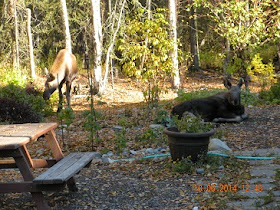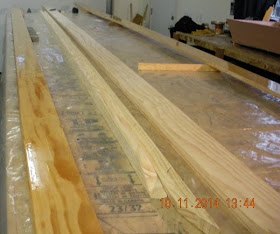Building the Side Panels of the BW
The side panels will be cut from 4-foot x 24-foot 9mm (3/8-inch) meranti.
Panel Selection
Since the BW will be finished bright (natural wood) I spent some time selecting which six 4x8 sheets will be used. I laid all ten sheets out, removed the ugly ones then tried to mate similar grain patterns and colors. |
| Panel selection |
Scarphing and Gluing
Then, as usual, cut the scarphs. Even though the final side panels will be only 32 inches wide, I chose to scarph, glue and 'glass the full 48-inch width since I can use the excess 16 inches x 24 feet boards for other parts such as the side panel backers under the knees.
 |
| 9mm sheet clamped for scarph cut |
After dry fit-up of the joint and clamping the plywood sheets to the work surface so they cannot move, I placed a scrap block under one of the sheets to elevate the joint so I could access both faces of the joint for gluing.
 |
| Plywood sheet elevated for access. Pre-wet both faces of the joint with un-thickened epoxy then apply thickened epoxy. |
Then clamp them to squeeze a little thickened epoxy out everywhere to ensure that there are no voids in the joint.
 |
| Thickened epoxy oozing out. |
 |
| After the excess epoxy is done oozing out, which can take up to 30 minutes, remove the excess before it cures. That is a lot easier than removing it after it cures. |
When gluing the scarph joints, I kept the outside of the side panel up. That way, I could do my best to make the final scarph joint look nice since the finish will be bright. I can't access the other side of the scarph joint and it will probably be an ugly scarph joint. However, the ugly scarph joint will be on the inside of the boat and the inside of the boat will be so busy with knees, fuel tanks, helm, lockers, etc. that the ugly scarph joint will not be noticed.
'Glassing the Side Panels
I chose to glass the side panels now, while they are conveniently laying on my work surface. I 'glassed the full 48-inch width of one side but I 'glassed only 32 inches of the other side so that both sides of the side panels have 'glass set in epoxy.
The extra 16-inch x 24-foot piece will have 'glass on one side only. The un-glassed side will be laminated so 'glass is not needed on both sides of the 16-inch x 24-foot piece .
 |
| Saturating the glass with un-thickened epoxy and being vigilant about squeegeeing the epoxy on thin so the 'glass does not float off of the plywood. |
 |
| After the epoxy cures I will remove the dross and fill the weave. |
After the epoxy cures, I use a utility knife to cut away the dross. That leaves a really sharp serrated knife edge in the 'glass/epoxy that needs to be sanded to avoid cutting yourself. I learned this the hard way long ago.
Also, do not fill the weave until after the first epoxy layer is cured. If you try to fill the weave before the first epoxy layer is cured, you will float the 'glass off of the plywood leaving ugly waves in the
finished 'glass.Filling the Weave
After the epoxy has cured the weave of the fiberglass is still providing relief to the surface. After filling the weave with unthickened epoxy, the weave is invisble and the surface looks like varnished natural wood.
 |
| Pour un-thickened epoxy on the surface, roughly spread it with a squeegee, fine spread it and tip with a foam brush. Use small batches of epoxy so it does not start to cure before tipping. |
 |
| Filling the weave on the side that received fiberglass on the 32-inch portion only. |
 |
| Weave filled |
 |
| Let the weave-filling epoxy cure then remove the unused 16-inch width of fiberglass. |
Flopping Panels
Working alone, I rigged overhead pulleys and ropes to help with lifting. Here is a sequence of photos showing flopping a 4-foot by 24-foot panel.
Cutting the Side Panels
Weave is filled and it is time to cut the side panels to the plan dimensions.
The factory edges of the plywood sheets were not aligned perfectly since I elected to align the sheets as needed for nice looking scarph joints. So I need a straight edge for the baseline.
 |
| I struck a chalk line, set a straight edge and cut a baseline. |
 |
| Measure off of the baseline and cut the side panel to its final 32-inch width. |
| Stations and offsets for the BW side panels |
 |
| Lay out offsets at each station according to the plans and use a supple batten to draw a fair curve. |
 |
| Lay the panels together, in mirror image (inside out), and cut the curve with a jig saw. The curve will be sanded fair later. |
 |
| Separate the panels and cut a 20° bevel on the bottom edge of the panel (chine). |
 |
| While the side panels are still atop each other, drill the stitch holes for future stitching at the chine. |
 |
| Bottom and side panels suspended from the ceiling. |































































